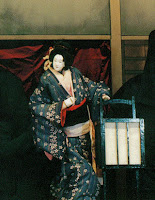Bunraku (Japanese: 文楽), also known as Ningyō jōruri (人形浄瑠璃), is a form of traditional Japanese puppet theater, founded in Osaka in 1684.
Three kinds of performers take part in a bunraku performance:
- Ningyōtsukai or Ningyōzukai - Puppeteers
- Tayū - the chanters
- Shamisen players
The most accurate term for the traditional puppet theater in Japan is ningyō jōruri. The combination of chanting and shamisen playing is called jōruri and the Japanese word for puppet is ningyō. Puppet plays are believed to have their origins in the 10th or 11th century. Itinerant entertainers, many from Awaji Island in the Seto Inland Sea, presented plays in the nearby cities of Osaka and Kyoto.
Originally, Bunraku( Japanese puppet theater), is probably the most developed form of puppetry in the world. It is closer in style to Punch and Judy than Pinnochio as there are no strings and in its early days the puppeteers were hidden behind a curtain. The puppets are large - usually about one-half life size and the main characters are operated by three puppeteers. Many bunraku plays are historical and deal with the common Japanese theme of giri and ninjo which is the conflict between social obligations and human emotions. The greatest works by Japan's most famous playwright Chikamatsu Monzaemon (1653~1724) are bunraku plays, many of which are written around this kind of conflict.
Bunraku is a combination of puppetry, joruri and musical accompaniment provided by the three-stringed shamisen, began in the Edo Period (1600~1868) in Osaka. As example of kabuki before it, in the 1600's bunraku became the common man's equivalent of the noh, which only the aristocracy were allowed to study. It flourished from the end of the 17th century, thanks particularly to the popular collaboration of the chanter Takemoto Gidayu I with Chikamatsu. Chikamatsu's Love Suicides at Sonezaki (1703, Sonezaki Shinju) is equivalent in stature and theme to Shakespeare's Romeo and Juliet. The play, based on an actual recent love-suicide, was so popular that it caused an increase in this kind of suicide until the government made it illegal. The concept of basing a play on a recent event was revolutionary and really caught the imagination of the public. The most famous bunraku play is probably Chushingura: The Treasury of Loyal Retainers (Kanadehon Chushingura), a story of heroics, loyalty and revenge, which has also been made into a famous kabuki play and filmed many times.

The omozukai, or main puppeteer, manipulates the head and features and the right arm while the two lower ranked puppeteers operate the left arm and the legs (with a 10-year long apprenticeship on each before becoming an omozukai). The omozukai is visible to the audience which he is the star of the show. After that, there often colorfully dressed while the other operators are 'invisible'. But actually they are just cloaked in black robes and hoods. Puppets of female characters usually don't have legs as they are clad in full-length kimono.
Since the Meiji Period (1868~1912), when Western culture became increasingly popular, bunraku has been in decline and relies on government sponsorship and revenue from the National Theater in Tokyo and the National Bunraku Theater in Osaka. When the National Theater opened in 1966, it was the first permanent home bunraku had had in almost 150 years. Although there are occasional increases in popularity, the real problem lies in the fact that the craftsmen who create the puppets and costumes are dying out and the long apprenticeship necessary to take their place does not appeal to today's young generation.

A bunraku puppet's head. This particular puppet is a head used in Sanbaso performances
 A 'musume' or maiden puppet head
A 'musume' or maiden puppet head A 'bunshichi' or warrior puppet head
A 'bunshichi' or warrior puppet head
The character Osono, from the play Hade Sugata Onna Maiginu, in a performance by the Tonda Traditional Puppet Troupe of Nagahama, Shiga Prefecture

A scene from Date Musume Koi no Hikanoko, in which Oshichi, the greengrocer's daughter, climbs a fire tower on a snowy night to sound a false alarm in order to save her lover. A performance at the Tonda Traditional Puppet Hall in Nagahama, Shiga Prefecture.
posted by:~yin~
No comments:
Post a Comment